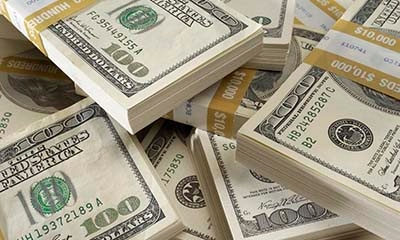October 5, 2016

Monsanto today released fourth quarter and fiscal year 2016 results.
The company reported a net loss of $191 million in the fourth quarter of fiscal year 2016, compared with a reported net loss of $495 million in the same period last year. Net income attributable to Monsanto for fiscal year 2016 was approximately $1.3 billion compared to net income of $2.3 billion attributable to Monsanto in fiscal year 2015.
Related: USDA approves Monsanto's dicamba-tolerant GMO cotton, soy traits

Monsanto reported a net loss of $191 millioin in the fourth quarter of fiscal year 2016. Net income attributable to Monsanto for fiscal year 2016 was approximately $1.3 billion.(Photo: moodboard/Thinkstock)
The company's fiscal year 2016 EPS on an as-reported basis was $2.99, reflecting costs associated with restructuring actions, Argentine-related tax matters, environmental and litigation matters and income from discontinued operations. On an ongoing basis, this translated to $4.48.
For the fourth quarter, the company reported $0.44 loss per share on an as-reported basis, which translated to $0.07 earnings per share on an ongoing basis.
The ongoing EPS results were better than fiscal year 2015, driven by the $157 million gain from the formation of the sorghum joint venture with Remington, a strong start in South America and lower seed returns in the U.S.
Monsanto reported net sales of $2.6 billion for the fourth quarter of fiscal year 2016. Net sales for the full fiscal year were $13.5 billion.
Full-year net sales were down year-over-year, due primarily to currency headwinds and a challenging agricultural environment.
The company's total operating expenses were basically flat year-over-year on an as-reported basis.
“Despite challenges to our business in fiscal year 2016, we delivered on the drivers that position Monsanto for the return to EPS growth in the year ahead. To see it through, our fiscal year 2017 priorities are focused on delivering on the operational plan and key business milestones for the year, while also executing on the necessary steps to close the deal with Bayer. Ultimately, we believe that combining with Bayer represents the most compelling value for our shareowners, with the most certainty through the all-cash consideration,” said Hugh Grant, Monsanto chairman and CEO.
Outlook
The company expects strong cash flows and growth in EPS in 2017. For fiscal year 2017, Monsanto expects to achieve EPS of $3.83 to $4.35 on an as-reported basis. This includes an estimated $0.20 to $0.24 in anticipated restructuring charges, $0.10 to $0.13 in Argentine-related tax matters and $0.27 to $0.34 in proposed Bayer transaction related costs. On an ongoing basis, this translates into an EPS estimate of $4.50 to $4.90. These estimates assume currencies are relatively stable year-over-year.
The company expects net cash provided by operating activities to be $2.4 billion to $2.8 billion, and net cash required by investing activities to be approximately $1.0 billion to $1.2 billion, assuming the successful sale of the Precision Planting equipment business and a meaningful first year investment in its dicamba production facility. All together, this translates into expected free cash flow of $1.4 to $1.6 billion.
Four areas of focus
In fiscal year 2017, Monsanto remains focused on the following key areas:
1. Growth from Core Seeds and Genomics Segment: The company expects Seeds and Genomics segment gross profit to increase in the mid-single digits as a percent year-over-year, with soybean gross profit alone expected to grow by more than 20%. This is expected to be primarily driven by increases in Intacta RR2 PRO and Roundup Ready 2 Xtend soybean penetration and related trait fees, and an anticipated significant reduction in the cost of goods sold related to the launch of Roundup Ready 2 Xtend soybeans. Growth in corn is expected to come from global genetic share gains and germplasm mix lift in local currency. Finally, strategic licensing opportunities are expected to provide an overall contribution of approximately $200 million in 2017, with roughly $60 million assumed in this segment’s gross profit and in the latter half of the fiscal year.
2. Strategic Management of Agricultural Productivity Segment: The company expects the Agricultural Productivity segment to deliver $900 million to $1 billion of gross profit, as it remains consistent with its strategy to price slightly above generics. The company also plans to maintain its emphasis on cost discipline and a focus on the construction of the new dicamba facility.
3. Business Transformation and Strategic Spend Discipline: The company’s restructuring and cost-savings plans are on-track, with an opportunity to deliver approximately $380 million in annual savings in operating expenses and cost of goods sold at the close of 2017. However, overall operating expenses in 2017 are expected to increase slightly with inflation and the costs associated with the return to growth. This is expected to more than offset the savings from restructuring and cost-savings plans.
4. Combination with Bayer: The company reiterated confidence in the timelines to close the deal with Bayer by the end of calendar year 2017.
Related: Bayer, Monsanto say they will create ‘innovative engine’ for ag
“We are entering a new era in agriculture, where growers are demanding new solutions and technologies to be more profitable and more sustainable,” Grant said. “We believe that combining with Bayer secures our shared vision to provide a wide set of solutions to meet these demands and feed a growing world.”
Returns by segment
The Seeds and Genomics segment consists of the global seeds and related traits business, biotechnology platforms and digital agriculture. Seeds and Genomics segment sales in the fourth quarter were $1.6 billion. For fiscal year 2016, the company realized Seeds and Genomics segment net sales of $10.0 billion, which declined primarily due to unfavorable currency, higher discounting in corn in the U.S. and price declines in cotton in India as a result of new government regulations. This was partially offset by record U.S. corn seed volumes, the benefit from the alfalfa licensing deal with Forage Genetics and outstanding penetration of Intacta RR2 PRO technology. In the area of digital agriculture, paid acre adoption of Climate FieldView rose to greater than 14 million acres in 2016, with total platform acres at 95 million.
The Agricultural Productivity segment consists of the crop protection products and lawn-and-garden herbicide products. Segment sales for the quarter were $997 million. For the fiscal year, the segment delivered net sales of $3.5 billion. A decline of $1.2 billion in net sales year over year was primarily due to lower pricing for glyphosate-based herbicides, the absence of the $274 million licensing deal with Scotts that occurred in fiscal year 2015 and lower volumes.
Source: Monsanto
You May Also Like




